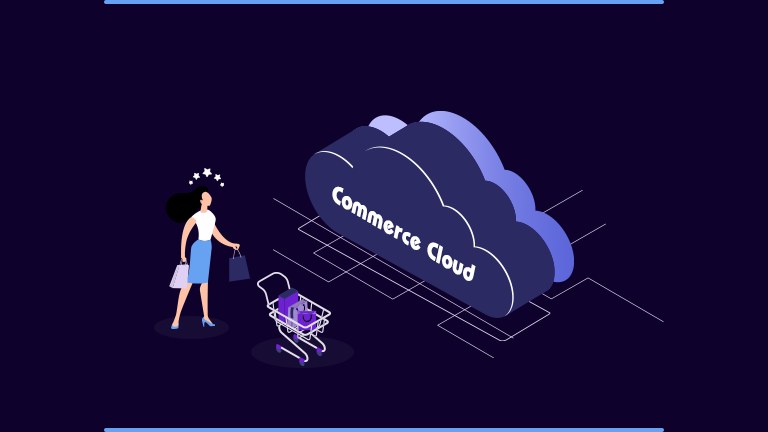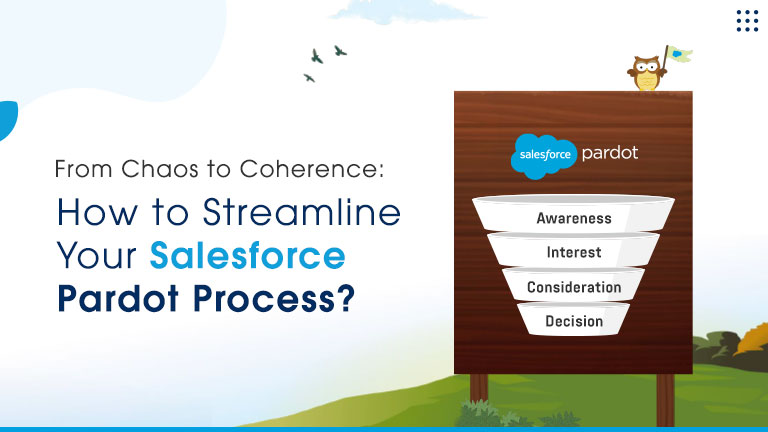AI Sales Agents Drive Revenue, Free Teams for Key Deals Learn more

How do your customers behave when they visit your website? What makes them lead your product “add to cart” or exit your site? Every answer related to customers' behaviour and steps, once they visit an online store, is a customer journey. A customer’s journey is a documented behavioural scenario that creates a map of the virtual footprints of your customer. It might sound crazy, but with marketing solutions like Commerce Cloud, everything is possible.
Today, the customer journey is not a straight line but leads dramatically from marketing to sales to service. With the help of Salesforce’s Commerce Cloud, you can view that journey and make it efficient to buy and repeat.
Before directly diving into how Commerce Cloud works, let’s check for the phases a customer leads through.
Stepping stones of Customer Journey -
- Awareness- Whether social media ads or word of mouth of existing customers, brand awareness spreads through various mediums. This is your effort to let customers recognise your brand or product.
- Accusation- The phase where customers turn into a lead with some sort of interaction is an accusation. This could be anything such as a form filling, subscribing to the newsletter, app download, following the link to your website, and creating an account.
- Onboarding- When they take service from you or buy a product, this is the highest of their interest. This is the time your customers provide the most personalized expertise, so remember to be relevant and helpful rather than noisy and hype.
- Engagement- In transforming your customers into loyal ones, you need to create engagement. Keeping customers engaged, building loyalty, and making them buy again, demands engagement. For this, create personalized content that makes customer relationships fresh and interesting.
- Retention- In case you find your customer is losing interest & at the risk of leaving, identify the causes and make sure you bring them into the sales funnel again. Or at least make way for a little easier to come back.
- Advocacy- Nothing can be more powerful for a business than a happy customer. If you have them, let the others know that too. Offer your customers an opportunity so they could write feedback or reviews about your service or product.
Now, when collecting the data from phases of the customer journey, let’s now create the blueprint.
Blueprint of the customer journey-
Identify customers- To know your customers, put yourself in the customer's shoes and walk their journey. Know their requirements, choice, like-dislike, experiences and their pain point.
Highlights:
- Demographics
- Life goals & challenges
- Requirements
- Like and dislike
- Engagement channels
- Most inclusive factors
- Other information
Step definition- To identify what are the steps your customers follow to reach or not to reach your products. Here are the steps they follow most of the time:
- Research through search engines
- Visit a brand website
- Check for the features and price
- Other brands/product comparison
- Make a purchase
- Product use
- Buy the same or different product based on product experience
Mark the touchpoints- Touchpoints are the medium from visitor lead to the product or services. Here they could be:
- Google ads
- Organic search engine results
- Social media
- Salespeople
- Your website’s pages
- Other listing websites
- Mobile app
- Stores
- Referable link
- Reviews
Check for the content- Content or the information should be relevant, interesting and helpful. Take time and identify how you solve your customer’s issues by providing them with a solution and then write content according to it.
- Identify the type of content such as videos, blogs, podcasts, social media posts, emailers, webinars, newsletters.
- Which types of content offer you the most the interaction
- Do your customer find your content as a trustable source of information
Choose the channel- From various channels you used to connect with your customers, they interact with the most and lead to the buying process. Here is the strategy:
- Channels you use, such as the web, social media, emails, mobile.
- Which channel is performing best?
- Which channel are you staggering with?
- What are the channels you like to use but need professional help with?
- How can you create a meaningful moment and impact?
This all turned into a simple process by using the Commerce Cloud. Here is how it helps you:
Commerce Cloud Benefits: Effect on Customer Journey
In the starting part of this article, you must read about the phases of the customer journey. Here you will understand how Commerce Cloud helps with each of those phases.
1) In generating awareness- Salesforce Commerce Cloud provides you with a single source of trust that supports you with data related to:
- Ad impressions and clicks
- Social listing
- Search volume
- Social media engagement
- Domain authority
- Share of voice
- Score information
- Brand mentions
2) In accusation- In a phase where the customer behaves like a lead, you don’t want to miss the chance to offer a personalised customer experience. Here is the data that can help you:
- Website/mobile app traffic
- Traffic of a specific channel
- Bounce rate, CTR and conversion rate
- New vs returning customers
- Cart abandonment rate
- Email open rate
- List growth rate
3) Onboarding- In a phase where you want to provide a valuable first impression, here is the data you need to know about:
- Accounts created
- Connect integration
- Demographics of users
- Content interaction
- Features accessed
- Customer service related information
4) Creates engagement- Keeping customers your regular & loyal customers, you need to go over the top to engage them. Here is what you can do?
- Transactional data
- Email opening rate
- The time they spend on your page or product
5) Helps in retention- In case of changing customers' behaviour, this is how the Cloud helps you to re-engage them.
- Return and cancellation rate
- Customer satisfaction
- Likelihood to repurchase
- Cross-sells, upsells, renewed reorders
- Unsubscribe rate
6) Advocacy- To let others know when your customer likes your product is the best free of cost way of marketing your service & product. Here are some of the useful metrics:
- Content sharing
- Customer review & referrals
- Influencer endorsements
- Social proofs
Summing it up!
The well-blown article is the sum of everything crossed through a customer journey. Where we mentioned customer journey phases on how to create a map. The most crucial part in the last sessions was where we shared insights about each part of data that could help you make customers attract, engage, buy, and repeat.
Looking for the same? A Salesforce Commerce Cloud Service can help!




